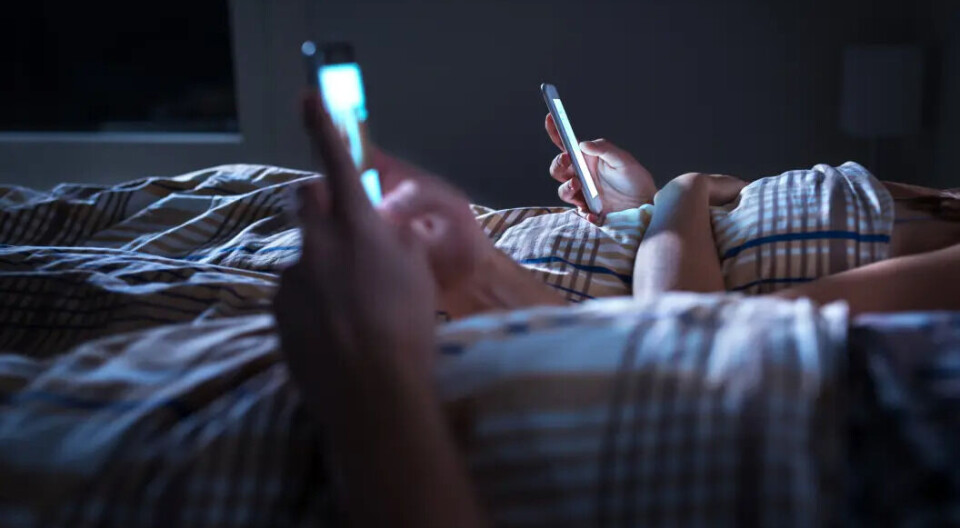THIS CONTENT IS BROUGHT TO YOU BY University of Oslo - read more
Is it okay to use your phone in bed?
“We're in the midst of a digital backlash”
Even though digitalisation is in full swing, most Norwegians are now ambivalent about life online, according to media researchers.

An increasing number of individuals today recognise the drawbacks of a mobile and screen-based lifestyle, according to media researchers at the University of Oslo.
This perspective marks a shift from the optimism that dominated when the internet became widely accessible at the turn of the millennium.
“We see various reactions, from activism focused on mobile use in schools to political initiatives and debates. Although people aren't logging off permanently, they're finding different ways to take digital breaks,” says Trine Syvertsen.
She is a professor of media studies and leader of a large research project on digital media use.
However, changing these habits is not an easy task.

“There has always been scepticism towards media technology. What sets the current situation apart is that we now live in an attention economy, where companies profit from capturing our attention. Our personal data has become the most valuable currency. This makes the pressure more intense," she says.
The hopes for the internet were high
Syvertsen recently published the book The Digital Backlash and the Paradoxes of Disconnection, where she, along with researchers from various countries, explore what they call a digital backlash.
She notes that in the 20th century, television faced the most resistance, primarily due to its tendency to induce passivity among viewers.
“When the internet first emerged, many believed it would be the path to democracy and dialogue. But around 2010, after the advent of smartphones and social media, the first signs appeared that the optimism was beginning to wane a bit,” says Syvertsen.
That is when she first read a book about digital detox, also called digital disconnection.
“Back then, it might have been about logging off for a year. Today, we might consider logging off for a weekend,” she says.
Around 2014–2015, apps designed to help us disconnect emerged. At the same time, summer camps without mobile devices started appearing. Then, around 2018, the scandals began: Social media platforms were using people's personal data without consent.
These revelations sparked strong reactions.
Sleeping bags for smartphones
Syvertsen and her co-authors have identified a broad trend encompassing everything from individual efforts to disconnect to public debates about Big Tech companies.
They believe that measures are being implemented on three levels: political, individual, and within civil society.
“For instance, politicians might regulate platforms or ban mobile phones in schools. The EU is also considering legislation that would govern employees' right to disconnect after work hours,” says Syvertsen.
Individuals are taking their own measures, such as deleting apps or setting aside their phones.
Civil society includes everything from organisations to cafes and groups of friends. There is significant activity occurring in this space, such as:
- Meditation camps with digital detox included
- Phone-free meetings and spaces
‘Log off and read’ events at universities
- Distribution of phone sleeping bags in libraries
Even tech companies have jumped on the trend, introducing products like boxes designed to hold your phone. In 2019, a Swedish trade association even dubbed such a box the ‘Christmas Gift of the Year,’ a detail that the authors highlight in their book.
The responsibility falls on the individual
Syvertsen points out that one of the challenges is that smartphones combine entertainment and distracting features with essential functions. These include buying bus tickets or unlocking the door at home.
“People need their phones, and this creates a dilemma. The responsibility for finding a balance in usage falls largely on the individual,” she says.
This is also true when a telecom operator launches a 'pause box' for phones, she highlights.
“It ultimately falls on you to take responsibility. Meanwhile the companies continue to offer services aimed at increasing usage and profits,” she says.
Women feel their screen time is excessive
The media researchers interviewed over 100 teenagers and adults in Norway and conducted a representative survey.
The survey revealed that 65 per cent of women believe they spend too much time on their phones, compared to 50 per cent of men. Since 2018, these numbers have risen for both genders, but the increase is particularly pronounced among women.
“Many express that action needs to be taken, but when asked directly about the necessity of public regulations, they remain uncertain. They acknowledge the many useful aspects of social media,” says Syvertsen.
The surveys also indicate that conflicts over screen and mobile use are common in Norwegian homes.
“There's a great deal of blaming and shaming. People tend to blame each other and are often more content with their own phone habits than those of others,” she says.
Divided opinions on mobile use in bed
Overall, more women than men report putting their phones away.
Women are more likely than men to set aside their phones in situations like spending time with friends or family or when enjoying the outdoors.
Several etiquette norms have also developed regarding when to put phones away. For instance, 83 per cent of women and 73 per cent of men say they put their phones away during meals with others.
However, opinions are divided on certain situations. About half of those surveyed consider it acceptable to use a phone in bed, while the other half do not. Researchers have not observed significant gender differences on this issue, but they do note another interesting distinction.
“Among childless couples, significantly more report not having a phone in bed. Conversely, couples with children are more likely to bring their phones to bed. Perhaps they're trying to set their phones aside when the kids are present and catch up in bed?” says Syvertsen.
Reference:
Albris et al. (Eds.) The Digital Backlash and the Paradoxes of Disconnection, Nordicom, 2024. ISBN: 978-91-88855-95-4

This content is paid for and presented by the University of Oslo
This content is created by the University of Oslo's communication staff, who use this platform to communicate science and share results from research with the public. The University of Oslo is one of more than 80 owners of ScienceNorway.no. Read more here.
More content from the University of Oslo:
-
Queer opera singers: “I was too feminine, too ‘gay.’ I heard that on opera stages in both Asia and Europe”
-
Putin’s dream of the perfect family
-
How international standards are transforming the world
-
A researcher has listened to 480 versions of Hitler's favourite music. This is what he found
-
Researcher: "AI weakens our judgement"
-
New, worrying trend among incels, according to researcher




































